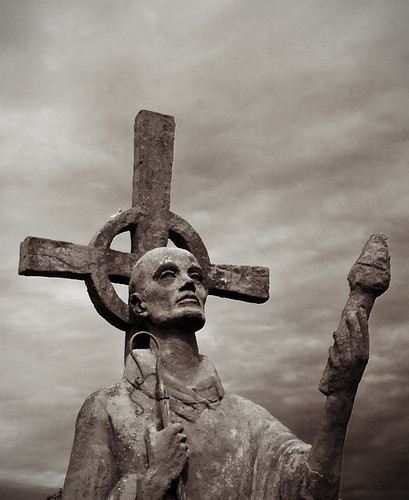 Ah… the good, old Celtic church. Sigh. What a group of radicals.
Ah… the good, old Celtic church. Sigh. What a group of radicals. 
As some of you know, I have a "thing" for the church in the British Isles from 300 A.D. to about 700 A.D. During this time, the Celtic church was more or less independent from the larger Roman Catholic Church (or anyone else for that matter…).
I say "more or less" because even though the Celtic church was outside of the leadership structure of the Roman Catholic Church, the monks still managed to obtain fiction and non-fiction scrolls. It just goes to tell you that bibliophilia is a powerful disease – overcoming wars and miles of once-charted oceans lands.
Yet, that's enough about that, let's move on too our book review!
When I first picked up this book, I was a tad skeptical – "oh great, ANOTHER evangelism book! This is just what the world needs…sigh."
However, I must state that after I finished the book, I was pleasantly trilled with how Hunter approached the topic. [@more@]
*laugh* 
Ok. I must confess. Even through the book is says it's about "evangelism" – it's really about contextual missions. There. I feel better.
Allow me to explain.
Between 300 to 700 A.D. there were too main models of spreading the Gospel or evangelism. The first model was that of the Roman church – in which the priest/missionary/evangelist:
- Presented the gospel message
- Waited for a decision
- And then entered into fellowship with the new believers.
Note that at the heart of this model was the idea that in order to become a Christian, one must first become "civilized" – which, of course, is another way of saying "becoming Roman".
The second model – that of the Celtic church – was to send teams into un-reached villages and:
- Enter into fellowship with the unbelievers
- Minister to them as the opportunity arouse
- Then, after folks trust and know you, invite them to follow Jesus.
You may say "ummm..Ardell, isn't that just relationship evangelism? I mean, that 'top topic' has left the dock years ago!"
In some ways, you are correct. The Celtic model is a type of relationship evangelism. However, it also differs (or at least it differs from my understanding of modern "relationship evangelism").
First off, the Celtic model is based upon community. There is a team – ten or twenty people – who work together to reach the pagans. As a result, the unbelievers in the village have the opportunity to see Christianity at work within a group setting – warts and all.
Second, it's deliberate – but not in a slimy, tricky, underhanded kind of way. The Celtic evangelists had a purpose – to love others and to start a church. However, they did not let this purpose undermined the fact that we are called by God to love other regardless of whether they join the church or not.
Third, and I love this part – the Celtic model allowed for the Mystery of God. The Roman Church – as is parts of the modern fundamental movement – liked to have everything explained logically. The Celtic culture was one that enjoyed the supernatural and mystery of an unexplainable Creator Lord.
Hmmm… This review is getting long… as such, I'm going to end it with one last comment.
Book good. Read if can.
Bye.
 Have you ever wondered why some churches included the phrase “we believe in the one, holy, invisible universal church” in their statement of faith or confession?
Have you ever wondered why some churches included the phrase “we believe in the one, holy, invisible universal church” in their statement of faith or confession?

 Yesterday we talked about the historical roots of the “Filioque Controversy.”
Yesterday we talked about the historical roots of the “Filioque Controversy.”

 I was browsing the shelves of my local library when I came across Yan Sen-Fu’s book about Nestorian Christianity in China. Talk about a find! It was awesome. 🙂
I was browsing the shelves of my local library when I came across Yan Sen-Fu’s book about Nestorian Christianity in China. Talk about a find! It was awesome. 🙂 Ah… the good, old Celtic church. Sigh. What a group of radicals.
Ah… the good, old Celtic church. Sigh. What a group of radicals. 

 The ancient Christian monks of Ireland would establish bases next to villages or trade routes with the hope that various strangers would stop in and say “hi”.
The ancient Christian monks of Ireland would establish bases next to villages or trade routes with the hope that various strangers would stop in and say “hi”.